
A kayak is a small, narrow human-powered watercraft typically propelled by means of a long, double-bladed paddle. The word kayak originates from the Greenlandic word qajaq.

Kayaking is the use of a kayak for moving over water. It is distinguished from canoeing by the sitting position of the paddler and the number of blades on the paddle. A kayak is a low-to-the-water, canoe-like boat in which the paddler sits facing forward, legs in front, using a double-bladed paddle to pull front-to-back on one side and then the other in rotation. Most kayaks have closed decks, although sit-on-top and inflatable kayaks are growing in popularity as well.
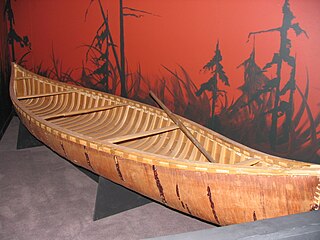
A canoe is a lightweight narrow water vessel, typically pointed at both ends and open on top, propelled by one or more seated or kneeling paddlers facing the direction of travel and using paddles.

Rafting and whitewater rafting are recreational outdoor activities which use an inflatable raft to navigate a river or other body of water. This is often done on whitewater or different degrees of rough water. Dealing with risk is often a part of the experience.
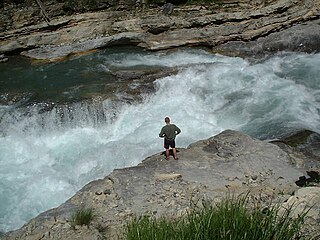
Whitewater forms in the context of rapids, in particular, when a river's gradient changes enough to generate so much turbulence that air is trapped within the water. This forms an unstable current that froths, making the water appear opaque and white.
A skeg is a sternward extension of the keel of boats and ships which have a rudder mounted on the centre line. The term also applies to the lowest point on an outboard motor or the outdrive of an inboard/outboard. In more recent years, the name has been used for a fin on a surfboard which improves directional stability and to a movable fin on a kayak which adjusts the boat's centre of lateral resistance. The term is also often used for the fin on water skis in the U.S. It has been used for the vertical fin on seaplane hulls and floats. The wear-bar on the bottom of snowmobile ski may also be called a skeg.
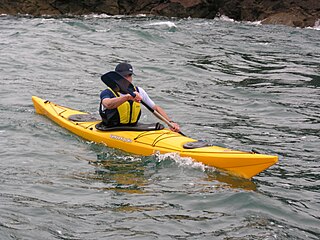
A sea kayak or touring kayak is a kayak used for the sport of paddling on open waters of lakes, bays, and oceans. Sea kayaks are seaworthy small boats with a covered deck and the ability to incorporate a spray deck. They trade off the manoeuvrability of whitewater kayaks for higher cruising speed, cargo capacity, ease of straight-line paddling (tracking), and comfort for long journeys.
A folding kayak is a direct descendant of the original Inuit kayak made of animal skins stretched over frames made from wood and bones. A modern folder has a collapsible frame made of some combination of wood, aluminium and plastic, and a skin made of a tough fabric with a waterproof coating. Many have integral air chambers inside the hull, making them virtually unsinkable.

Whitewater kayaking is an adventure sport where a river is navigated in a decked kayak. Whitewater kayaking includes several styles. River running; where the paddler follows a river and paddles rapids as they travel. Creeking usually involving smaller, steeper, and more technical waterways. Creek boats tend to be short but high volume to allow for manoeuvrability while maintaining buoyancy. Slalom requires paddlers to navigate through "gates". Slalom is the only whitewater event to be in the Olympics. Play boating involves staying on one feature of the river and is more artistic than the others. Squirt boating uses low-volume boats to perform special moves in whitewater features.

A spraydeck is a flexible waterproof cover for a boat with holes for the passengers' waists. Spraydecks are used to prevent water from entering the boat while allowing passengers to paddle or row.

Canoe slalom is a competitive sport with the aim to navigate a decked canoe or kayak through a course of hanging downstream or upstream gates on river rapids in the fastest time possible. It is one of the two kayak and canoeing disciplines at the Summer Olympics, and is referred to by the International Olympic Committee (IOC) as Canoe/Kayak Slalom. The other Olympic canoeing discipline is canoe sprint. Wildwater canoeing is a non-Olympic paddlesport.

Canoe freestyle is a discipline of whitewater kayaking or canoeing where people perform various technical moves in one place, as opposed to downriver whitewater canoeing or kayaking where the objective is to travel the length of a section of river. Specialised canoes or kayaks (boats) known as playboats are often used, but any boat can be used for playing. The moves and tricks are often similar to those performed by snowboarders, surfers or skaters, where the athlete completes spins, flips, turns, etc. With modern playboats it is possible to get the kayak and the paddler completely airborne while performing tricks. The competitive side of playboating is known as freestyle kayaking.

The Waveski, previously known as the "Paddle Ski” is a surfboard where the rider 'sits' on top of the surfboard. Waveski surfing is a dynamic sport combining paddle power with the manoeuvrability and performance of a surfboard. A Waveski resembles a larger volume surfboard, with the addition of a hollowed out seat with seat belt, foot straps and double ended paddle enabling the rider to remain attached to the board for maneuvers and to 'Eskimo roll' if overturned. The waveski rider or surfer uses a double-ended paddle while seated. To turn the rider uses their weight to lean on the side rails and paddle to pivot or propel the board up the wave. The sport is categorized under the International Canoe Federation. The discipline holds biennial World championship events, the next of which will be held at the Nahoon Reef, outside the town of East London, South Africa.

A surfski is a type of kayak in the kayaking "family" of paddling craft. It is generally the longest of all kayaks and is a performance oriented kayak designed for speed on open water, most commonly the ocean, although it is well suited to all bodies of water and recreational paddling.

Creeking is a branch of canoeing and kayaking that involves descending very steep low-volume whitewater. It is usually performed in specialized canoes and kayaks specifically designed to withstand the extreme whitewater environment in which the activity occurs. In addition, the canoes and kayaks give the paddler improved performance and maneuverability needed to avoid river obstacles.
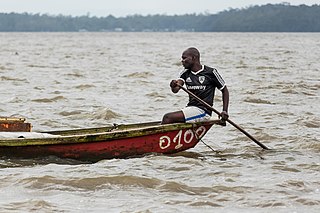
Paddling, in regard to waterborne transport, is the act of propelling a human-powered watercraft using at least one hand-held paddle. The paddle, which consists of one or two blades joined to a shaft, is also used to steer the vessel via generating a difference in propulsion between the two sides of the watercraft. The paddle is not connected to the boat, unlike in rowing where the oar is attached to the boat.

Standup paddleboarding (SUP) is a water sport born from surfing with modern roots in Hawaii. Standup paddleboarders stand on boards that are floating on the water and use a paddle to propel themselves through the water. The sport was documented in a 2013 report that identified it as the outdoor sporting activity with the most first-time participants in the United States that year. Variations include flat water paddling, racing, surfing, whitewater SUP, yoga, and fishing.
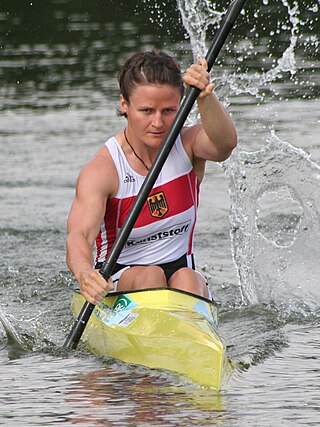
Sprint kayak is a type of canoe sprint held on calm water. The paddler is seated, facing forward, and uses a double-bladed paddle pulling the blade through the water on alternate sides to propel the boat forward. Kayak sprint has been in every summer Olympics since it debuted at the 1936 Summer Olympics. The sport is governed by the International Canoe Federation.

Whitewater canoeing is the sport of paddling a canoe on a moving body of water, typically a whitewater river. Whitewater canoeing can range from simple, carefree gently moving water, to demanding, dangerous whitewater. River rapids are graded like ski runs according to the difficulty, danger or severity of the rapid. Whitewater grades range from I or 1 to VI or 6. Grade/Class I can be described as slightly moving water with ripples. Grade/Class VI can be described as severe or almost unrunnable whitewater, such as Niagara Falls.

Canoeing – recreational boating activity or paddle sport in which you kneel or sit facing forward in an open or closed-decked canoe, and propel yourself with a single-bladed paddle, under your own power.


















